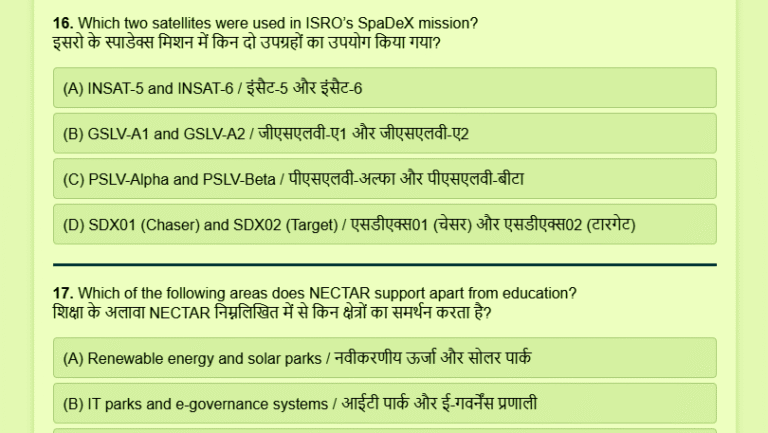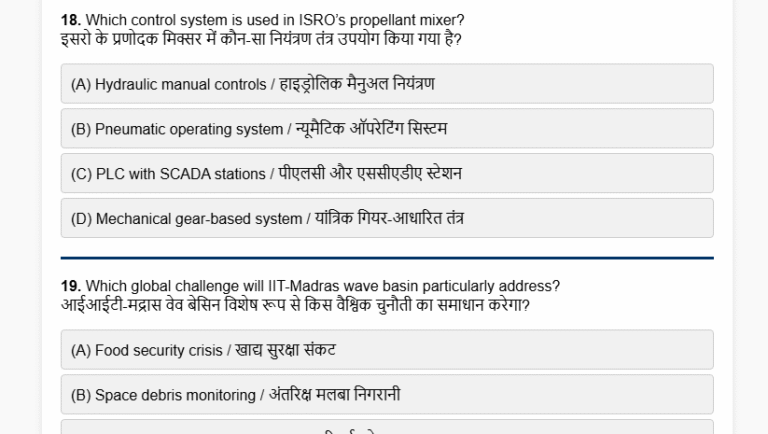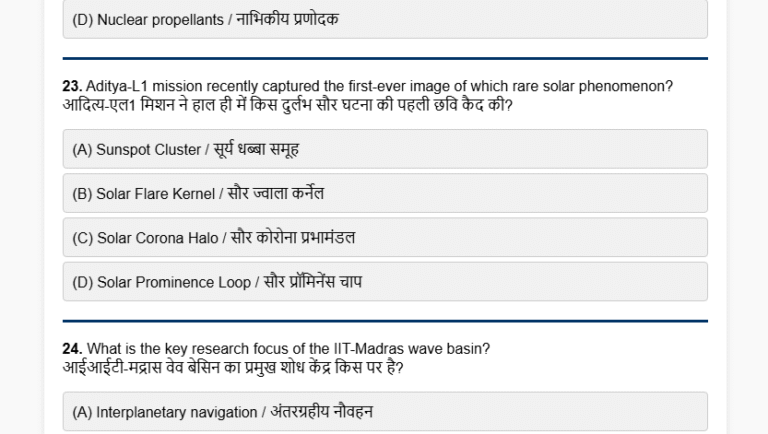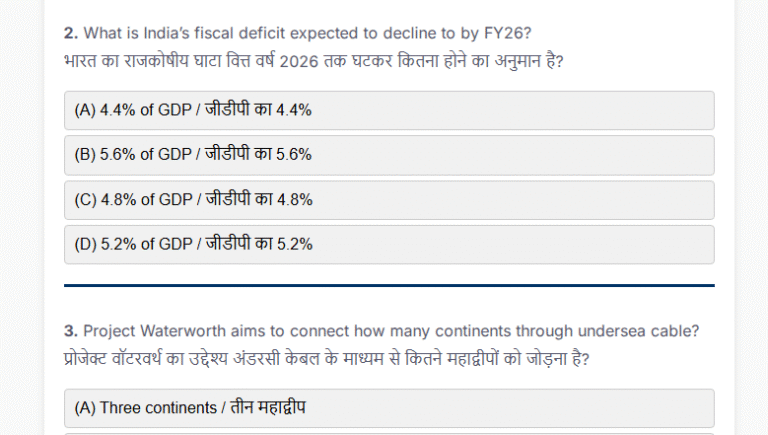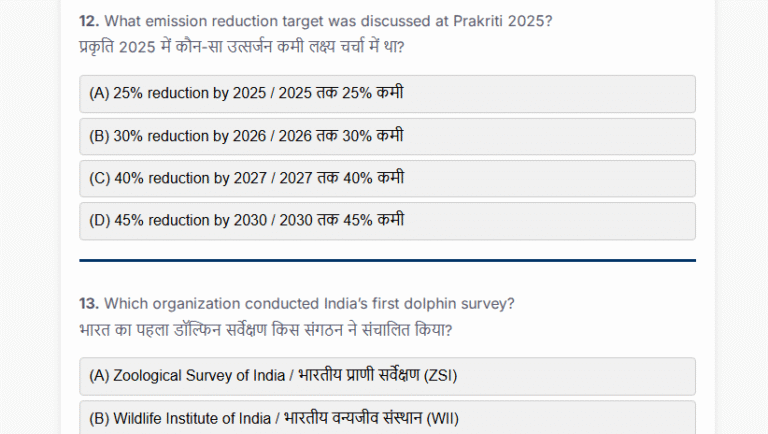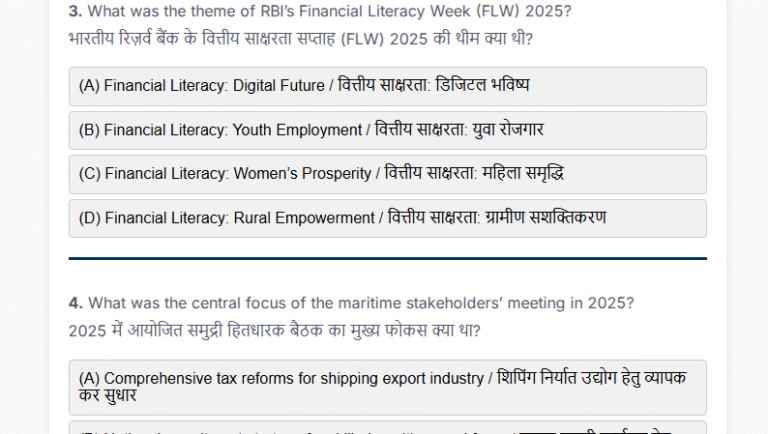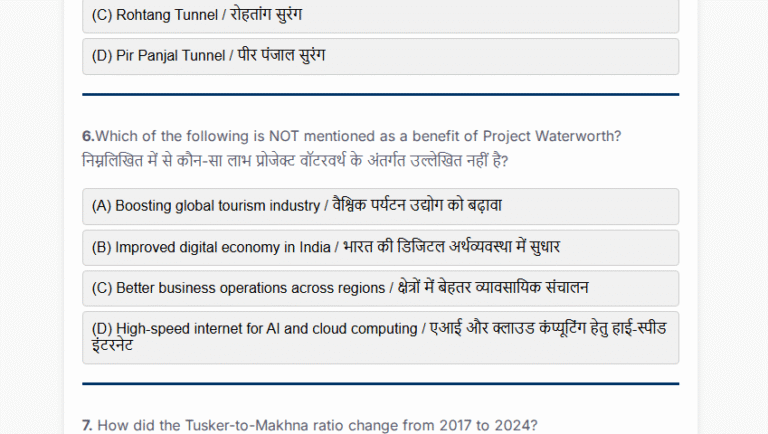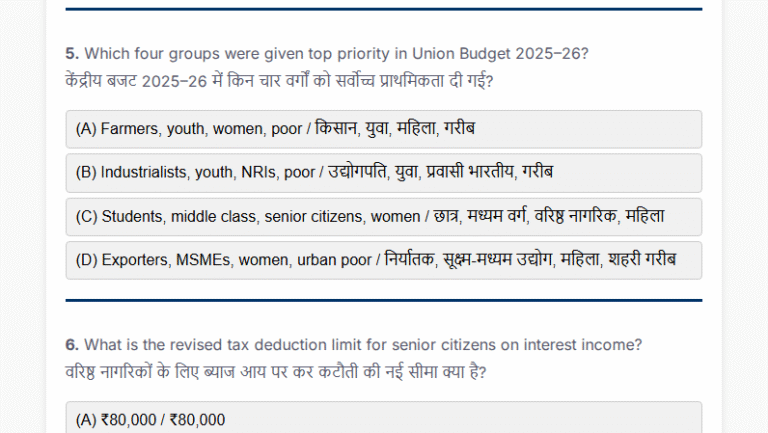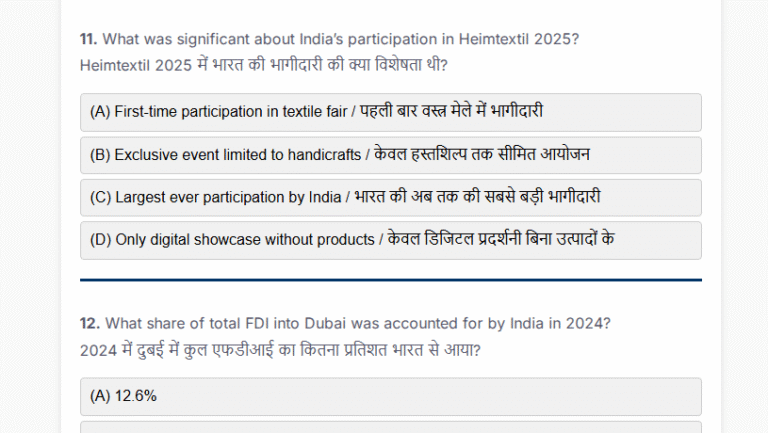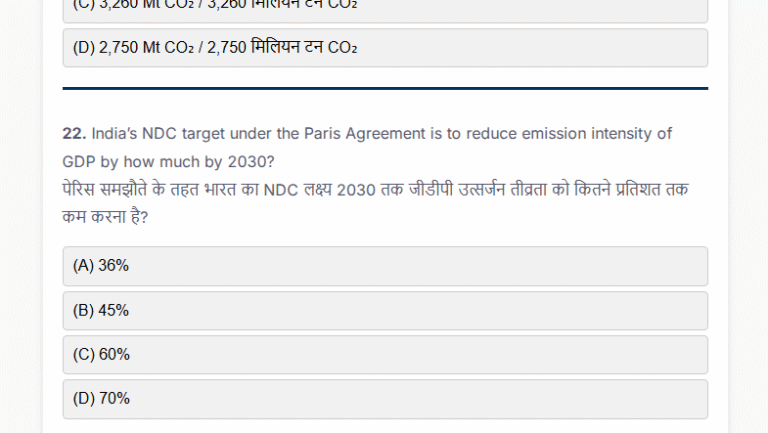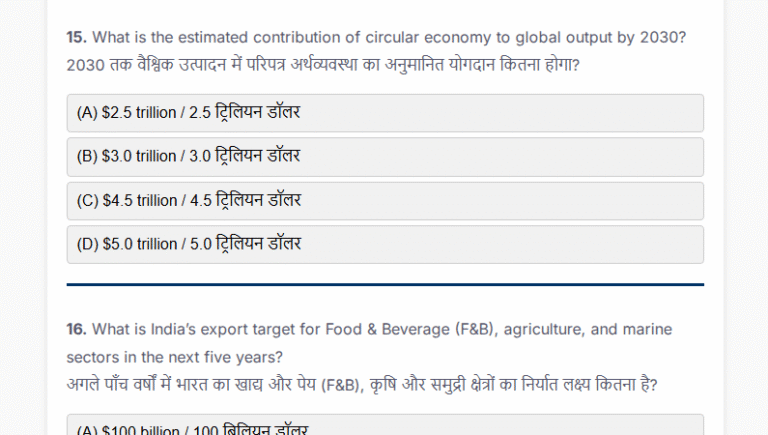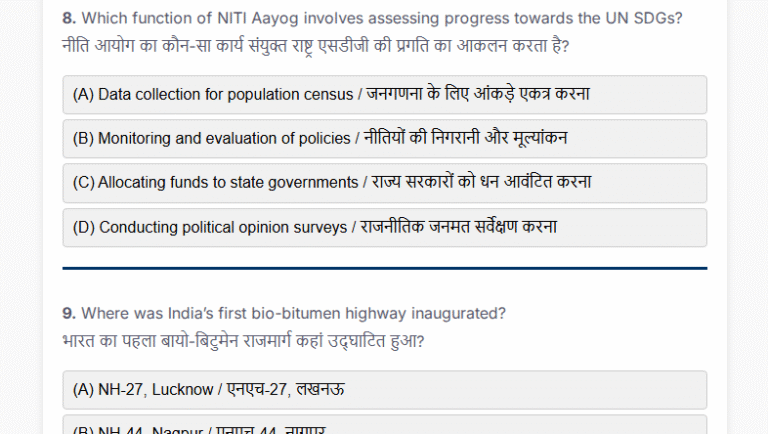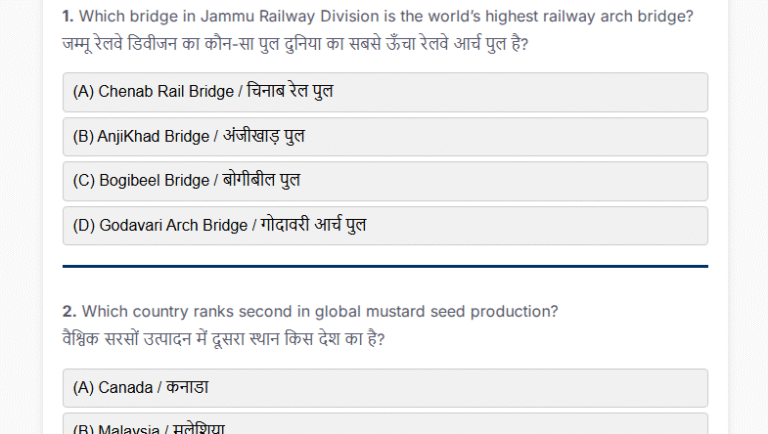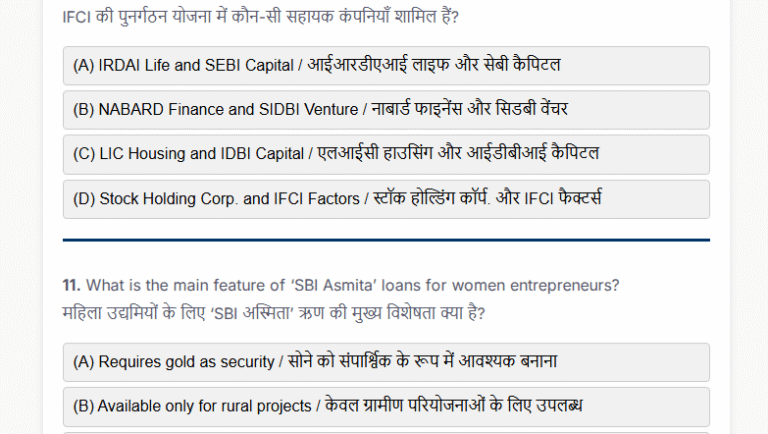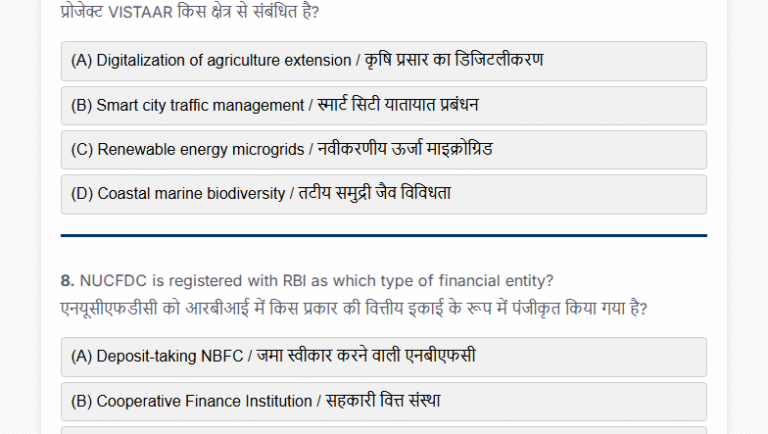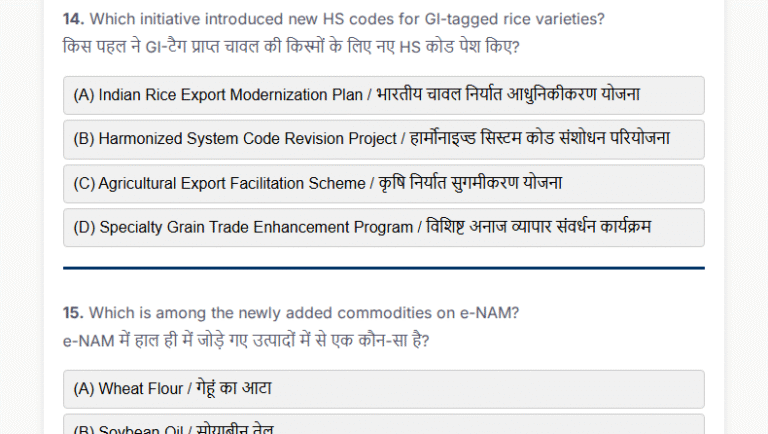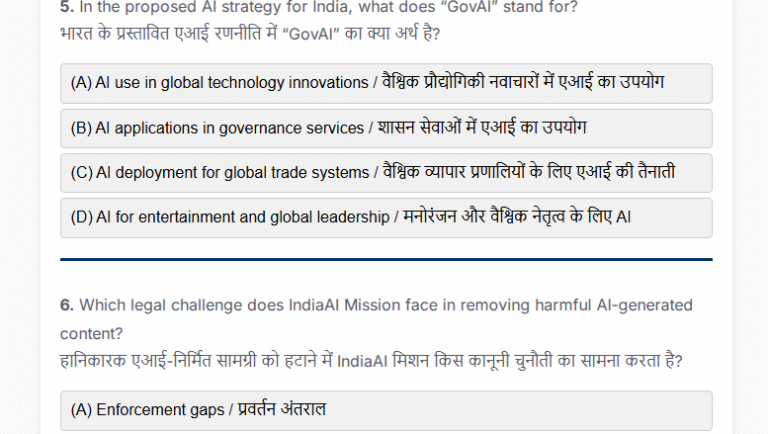Current Affairs Today MCQs (8 Nov 2024)
1. Which of the following cities is NOT part of the Uttarakhand Livability Improvement Project?
(A) Haldwani
(B) Vikasnagar
(C) Champawat
(D) Rishikesh
The correct answer is (D) Rishikesh
The Uttarakhand Livability Improvement Project, funded by a $200 million loan from the Asian Development Bank (ADB), focuses on improving infrastructure in five cities: Haldwani, Champawat, Kichha, Kotdwar, and Vikasnagar. The project aims to enhance urban livability by upgrading roads, traffic management, flood management, and water supply systems. Rishikesh is not included in this project. This initiative aligns with India’s commitment to improve urban infrastructure, especially in ecologically sensitive regions like Uttarakhand, ensuring sustainable development and better quality of life for residents.
2. What is the primary objective of establishing the Tuna Cluster in the Andaman and Nicobar Islands?
(A) To promote tourism in the islands
(B) To drive economic growth and improve incomes in the fisheries sector
(C) To establish a center for tuna breeding research
(D) To build more ports for military use
The correct answer is (B) To drive economic growth and improve incomes in the fisheries sector
The Tuna Cluster in the Andaman and Nicobar Islands, established under the Pradhan Mantri Matsya Sampada Yojana (PMMSY), aims to boost the fisheries sector, drive economic growth, and increase incomes for local stakeholders. The region’s vast Exclusive Economic Zone (EEZ) has untapped marine resources, particularly tuna, that offer significant commercial value. This cluster will focus on infrastructure for processing, export, and partnerships with tuna-fishing nations. By capitalizing on the potential of the Andaman and Nicobar Islands, the initiative strengthens India’s position in the global seafood market.
3. Vostro Accounts in India are currently used for:
(A) Cross-border lending and NRI investments
(B) Settling forex transactions and cross-border payments
(C) Domestic banking for Indian citizens
(D) Issuing loans to Indian exporters
The correct answer is (B) Settling forex transactions and cross-border payments
Vostro accounts allow foreign banks to hold funds in the Indian banking system, facilitating cross-border payments and forex transactions. The Reserve Bank of India (RBI) is considering expanding the scope of rupee vostro accounts to support cross-border lending, capital account transactions, and loans to NRIs. This move is part of India’s push to internationalize the rupee, increasing its role in global finance. Currently, Special Rupee Vostro Accounts (SRVAs) are operational with a few countries, including Russia, Sri Lanka, and the Maldives.
4. What are the two largest shareholders in the Asian Development Bank (ADB) as of 2023?
(A) India and Australia
(B) Japan and China
(C) Japan and the USA
(D) China and India
The correct answer is (C) Japan and the USA
Japan and the USA are the largest shareholders in the Asian Development Bank (ADB), each holding a 15.6% share as of 2023. Headquartered in Manila, Philippines, ADB was established in 1966 to support social and economic development in Asia and the Pacific. The institution provides loans, technical assistance, and investments to member countries for sustainable development. India, a founding member, has a 6.3% share in ADB, which has become a significant partner in supporting India’s infrastructure and economic initiatives.
5. What does the Government of India aim to achieve by introducing a new framework for vostro accounts?
(A) To increase cross-border trade in euros
(B) To establish an international banking hub in India
(C) To internationalize the rupee and integrate it into global finance
(D) To support Indian citizens in making forex transactions
The correct answer is (C) To internationalize the rupee and integrate it into global finance
The Reserve Bank of India (RBI) is working on a framework to broaden the use of rupee vostro accounts, aiming to internationalize the rupee. By allowing foreign institutions to use rupee holdings for activities such as NRI lending and cross-border transactions, India seeks to increase the rupee’s role in global finance. This move aligns with India’s objective to reduce dependency on foreign currencies and establish the rupee as a prominent currency in international trade, enhancing India’s financial influence globally.
6. Which of the following is a key species found in the global tuna market?
(A) Bluefin
(B) Kingfish
(C) Salmon
(D) Barracuda
The correct answer is (A) Bluefin
Tuna species dominate the global fish market due to their high commercial value, with major species including skipjack, yellowfin, bigeye, and albacore. Bluefin tuna, particularly valued in gourmet markets, is also part of this group. Known for their extensive migratory patterns, tuna travel long distances across oceans, making them essential to both ecological and economic systems. The establishment of the Tuna Cluster in the Andaman and Nicobar Islands aims to leverage these valuable resources for India’s economic growth, especially in the fisheries sector.
7. The Pradhan Mantri Matsya Sampada Yojana (PMMSY), under which the Tuna Cluster is being established, primarily focuses on:
(A) Marine conservation
(B) Employment in tourism
(C) Fisheries development and welfare of fish farmers
(D) Urban infrastructure development
The correct answer is (C) Fisheries development and welfare of fish farmers
The Pradhan Mantri Matsya Sampada Yojana (PMMSY) is a flagship scheme for the sustainable development of India’s fisheries sector and the welfare of fish farmers. The establishment of the Tuna Cluster in the Andaman and Nicobar Islands under PMMSY aligns with its goals by leveraging the region’s rich marine resources, particularly tuna, to boost India’s position in global seafood markets. The scheme’s objectives include increasing fish production, creating employment, and enhancing income for fishers, promoting holistic development in fisheries and allied sectors.
8. What is the primary purpose of the $200 million loan from ADB to India for the Uttarakhand Livability Improvement Project?
(A) Promoting tourism in Uttarakhand
(B) Building new schools and hospitals
(C) Improving urban infrastructure in selected cities
(D) Expanding agricultural activities in rural areas
The correct answer is (C) Improving urban infrastructure in selected cities
The $200 million loan from the Asian Development Bank (ADB) supports the Uttarakhand Livability Improvement Project, which aims to upgrade infrastructure in cities like Haldwani, Champawat, Kichha, Kotdwar, and Vikasnagar. The project focuses on improving roads, traffic management, flood management, and water supply systems, enhancing the quality of life for urban residents. This investment aligns with India’s urban development goals and strengthens ADB’s role in aiding infrastructure initiatives in its member countries.
9. Vostro Accounts, which the RBI is looking to expand for broader utility, are:
(A) Accounts held by Indian banks on behalf of foreign banks
(B) Accounts exclusively for Indian NRIs abroad
(C) Foreign exchange accounts for Indian companies
(D) Accounts meant for internal transactions within India
The correct answer is (A) Accounts held by Indian banks on behalf of foreign banks
Vostro accounts are accounts that Indian banks hold on behalf of foreign banks, enabling these foreign institutions to settle forex transactions and cross-border payments. The Reserve Bank of India (RBI) is exploring ways to expand the use of these accounts to support cross-border lending, capital account transactions, and loans to NRIs, with the goal of internationalizing the rupee. By allowing broader usage of vostro accounts, India aims to increase its currency’s role in international trade and reduce dependency on foreign currencies.
10. What is the geographical advantage of the Andaman and Nicobar Islands in promoting a Tuna Cluster?
(A) Its location close to the Indian Ocean’s Exclusive Economic Zone
(B) Its abundant freshwater resources
(C) Its proximity to European seafood markets
(D) Its cooler climate suitable for fishing
The correct answer is (A) Its location close to the Indian Ocean’s Exclusive Economic Zone
The Andaman and Nicobar Islands offer a strategic location in the Indian Ocean with access to an expansive Exclusive Economic Zone (EEZ), rich in marine resources like tuna. This geographical advantage makes the islands ideal for establishing a Tuna Cluster, which will capitalize on the untapped potential of the region’s fisheries resources. The cluster aims to boost economic growth, generate income, and enhance India’s seafood exports, positioning it as a key player in the global tuna market.
11. What is Agrivoltaic farming also known as?
(A) Bio-solar farming
(B) Agro-photovoltaic farming
(C) Dual-use solar farming
(D) Solar-hydro farming
The correct answer is (C) Dual-use solar farming
Agrivoltaic farming, also called dual-use solar or agrisolar farming, combines agriculture with solar energy production. Solar panels are installed 2-3 meters above the ground at a 30-degree angle to allow light, shade, and rainwater to reach the crops underneath. This approach enhances land efficiency by allowing simultaneous agricultural and energy production. Additionally, it provides partial shade to crops, increasing yield, and enables farmers to generate extra income from solar energy, optimizing land use for both energy and food production.
12. Which of the following is a benefit of Agrivoltaic farming?
(A) Reduces dependency on chemical fertilizers
(B) Generates additional income through solar energy
(C) Allows crops to grow without sunlight
(D) Eliminates the need for irrigation
The correct answer is (B) Generates additional income through solar energy
Agrivoltaic farming provides dual benefits: crop production and income generation through solar energy. By positioning solar panels above crops, farmers can produce electricity and benefit from income generated by selling surplus energy to the grid. The system also provides partial shade, which can enhance crop yield and reduce water evaporation. However, it does not eliminate the need for irrigation or reduce chemical fertilizer use directly, making the additional income from energy production one of its most significant benefits.
13. In the development of a Millimeter Wave Transceiver for 5G Rural Connectivity, which frequency range is used?
(A) 10 GHz to 30 GHz
(B) 300 MHz to 3 GHz
(C) 30 GHz to 300 GHz
(D) 1 GHz to 10 GHz
The correct answer is (c) 30 GHz to 300 GHz
The Millimeter Wave (MMW) technology utilizes electromagnetic waves in the 30 GHz to 300 GHz frequency range. This range enables high data transfer rates, which are essential for 5G and potential future 6G networks, as well as high-resolution imaging and sensing applications. The technology’s development, especially for rural connectivity, can help enhance broadband access and support high-speed internet in less accessible areas. By leveraging these high frequencies, the MMW technology ensures reliable, fast, and efficient communication.
14. Which organization is collaborating with IIT Roorkee to develop a Millimeter Wave Transceiver for 5G rural connectivity?
(A) ISRO
(B) Centre for Development of Telematics (C-DOT)
(C) National Informatics Centre (NIC)
(D) Bharat Sanchar Nigam Limited (BSNL)
The correct answer is (B) Centre for Development of Telematics (C-DOT)
The Centre for Development of Telematics (C-DOT), a research and development center under the Department of Telecommunications, is collaborating with IIT Roorkee to develop a Millimeter Wave Transceiver for enhancing 5G connectivity in rural areas. This partnership focuses on advancing MMW technology to improve connectivity and reduce dependency on external semiconductor fabrication industries. By involving institutions like C-DOT and IIT Roorkee, the initiative aims to foster local innovation, create Intellectual Property Rights (IPRs), and build a skilled workforce in millimeter wave technology.
15. What is a key advantage of using Millimeter Wave technology in 5G networks?
(A) It requires less infrastructure
(B) It provides high data transfer rates
(C) It reduces the need for antennas
(D) It operates in low-frequency bands
The correct answer is (B) It provides high data transfer rates
Tuna species dominate the global fish market due to their high commercial value, with major species including skipjack, yellowfin, bigeye, and albacore. Bluefin tuna, particularly valued in gourmet markets, is also part of this group. Known for their extensive migratory patterns, tuna travel long distances across oceans, making them essential to both ecological and economic systems. The establishment of the Tuna Cluster in the Andaman and Nicobar Islands aims to leverage these valuable resources for India’s economic growth, especially in the fisheries sector.
16. Which of the following is NOT a focus of the Millimeter Wave Transceiver project for 5G rural connectivity?
(A) Creating Intellectual Property Rights (IPRs)
(B) Supporting autonomous vehicle networks
(C) Developing a skilled workforce
(D) Encouraging local manufacturing units
The correct answer is (B) Supporting autonomous vehicle networks
The Millimeter Wave Transceiver project for 5G rural connectivity, initiated by C-DOT in collaboration with IIT Roorkee, primarily focuses on improving rural 5G connectivity, creating Intellectual Property Rights (IPRs), developing a skilled workforce, and encouraging small and medium industries to establish manufacturing units in India. Although MMW technology can support autonomous vehicles, the main goal of this project is to enhance rural internet access and reduce dependency on imported components, rather than focusing on autonomous vehicle networks.
17. Agrivoltaic farming panels are typically positioned at what height from the ground?
(A) 1-2 meters
(B) 2-3 meters
(C) 3-4 meters
(D) 4-5 meters
The correct answer is (B) 2-3 meters
In Agrivoltaic farming, solar panels are generally positioned 2-3 meters above the ground. This height allows sufficient sunlight and rainwater to reach the crops growing underneath while enabling access for farm machinery. The 30-degree tilt of the panels helps create an optimal environment for certain crops, enhancing yields and providing additional benefits such as partial shading. This setup exemplifies the dual-use principle by maximizing land utility for both agriculture and solar energy production.
18. The primary goal of the Millimeter Wave Transceiver project for 5G rural connectivity is to:
(A) Increase urban broadband speeds
(B) Reduce the cost of mobile data
(C) Improve connectivity in rural areas
(D) Develop infrastructure for satellite internet
The correct answer is (C) Improve connectivity in rural areas
The Millimeter Wave Transceiver project for 5G rural connectivity, developed by C-DOT in partnership with IIT Roorkee, focuses on enhancing internet access in rural areas. By using millimeter wave technology, the project aims to provide high-speed data transfer capabilities, essential for bridging the digital divide between urban and rural regions. It also seeks to promote local manufacturing, create jobs, and foster innovation in the telecom sector, making rural connectivity an integral part of India’s broader technological advancement goals.
19. One of the economic benefits of Agrivoltaic farming is:
(A) Increased cost of solar panel maintenance
(B) Higher expenses for crop protection
(C) Additional income from solar power generation
(D) Reduced crop yield due to shading
The correct answer is (C) Additional income from solar power generation
Agrivoltaic farming offers the potential for farmers to generate additional income by harnessing solar energy on the same land used for crop cultivation. This dual-use model not only increases land efficiency but also allows farmers to sell surplus electricity generated by solar panels to the grid. Furthermore, the partial shading provided by the panels can benefit certain crops, improving yields and potentially reducing water usage by lowering soil evaporation rates. This approach maximizes the economic output of agricultural land.
20. In Millimeter Wave Transceiver technology, which key industry could see reduced dependency as a result of local manufacturing initiatives in India?
(A) Renewable energy sector
(B) Telecommunications industry
(C) Semiconductor fabrication industry
(D) Heavy machinery manufacturing
The correct answer is (C) Semiconductor fabrication industry
The Millimeter Wave Transceiver project for 5G rural connectivity encourages the establishment of local manufacturing units, which would reduce India’s dependency on imported semiconductor components. By fostering a domestic manufacturing ecosystem, the project aims to support small and medium industries in producing high-frequency components for 5G infrastructure. This approach not only strengthens India’s telecom industry but also contributes to a more resilient supply chain, minimizing reliance on global semiconductor fabrication industries, which often face supply constraints and geopolitical issues.
Set 20 Quarterly CA 2025 Jan to March IMPORTANT INSTRUCTIONS This test consists of 25 questions.At…
Set 19 Quarterly CA 2025 Jan to March IMPORTANT INSTRUCTIONS This test consists of 25 questions.At…
Set 18 Quarterly CA 2025 Jan to March IMPORTANT INSTRUCTIONS This test consists of 25 questions.At…
Set 17 Quarterly CA 2025 Jan to March IMPORTANT INSTRUCTIONS This test consists of 25 questions.At…
Set 16 Quarterly CA 2025 Jan to March IMPORTANT INSTRUCTIONS This test consists of 25 questions.At…
Set 15 Quarterly CA 2025 Jan to March IMPORTANT INSTRUCTIONS This test consists of 25 questions.At…
Set 14 Quarterly CA 2025 Jan to March IMPORTANT INSTRUCTIONS This test consists of 25 questions.At…
Set 13 Quarterly CA 2025 Jan to March IMPORTANT INSTRUCTIONS This test consists of 25 questions.At…
Set 12 Quarterly CA 2025 Jan to March IMPORTANT INSTRUCTIONS This test consists of 25 questions.At…
Set 11 Quarterly CA 2025 Jan to March IMPORTANT INSTRUCTIONS This test consists of 25 questions.At…
Set 10 Quarterly CA 2025 Jan to March IMPORTANT INSTRUCTIONS This test consists of 25 questions.At…
Set 9 Quarterly CA 2025 Jan to March IMPORTANT INSTRUCTIONS This test consists of 25 questions.At…
Set 8 Quarterly CA 2025 Jan to March IMPORTANT INSTRUCTIONS This test consists of 25 questions.At…
Set 7 Quarterly CA 2025 Jan to March IMPORTANT INSTRUCTIONS This test consists of 25 questions.At…
Set 6 Quarterly CA 2025 Jan to March IMPORTANT INSTRUCTIONS This test consists of 25 questions.At…
Set 5 Quarterly CA 2025 Jan to March IMPORTANT INSTRUCTIONS This test consists of 25 questions.At…
Set 4 Quarterly CA 2025 Jan to March IMPORTANT INSTRUCTIONS This test consists of 25 questions.At…
Set 2 Quarterly CA 2025 Jan to March IMPORTANT INSTRUCTIONS This test consists of 25 questions.At…
Set 3 Quarterly CA 2025 Jan to March IMPORTANT INSTRUCTIONS This test consists of 25 questions.At…
Test Series of 1st Quarterly Current Affairs 2025 प्रथम त्रैमासिक करेंट अफेयर्स 2025 की टेस्ट सीरीज़…
Current Affairs Today MCQs (26 Nov 2024) 1. What is the primary purpose of the Rejang Dewa dance in…
Current Affairs Today MCQs (25 Nov 2024) 1. What feature distinguishes African penguins from other…
Current Affairs Today MCQs (24 Nov 2024) 1. Which of the following is a distinctive feature of…
Current Affairs Today MCQs (23 Nov 2024) 1. What is the target adaptation finance commitment for the…
Current Affairs Today MCQs (22 Nov 2024) 1. How many youth are targeted for internships under the PM…
Current Affairs Today MCQs (21 Nov 2024) 1. Which is the funding ratio for PM-JAY between the Centre…
Current Affairs Today MCQs (20 Nov 2024) 1. Who is eligible for the Ayushman Vay Vandana Card? (A)…
Current Affairs Today MCQs (5 Nov 2024) 1. What conditions contribute to the formation of the DANA…
Current Affairs Today MCQs (4 Nov 2024) 1. What is the primary function of Israel’s Iron Beam…
Current Affairs Today MCQs (3 Nov 2024) 1. To whom was the Balfour Declaration addressed? (A) David…


